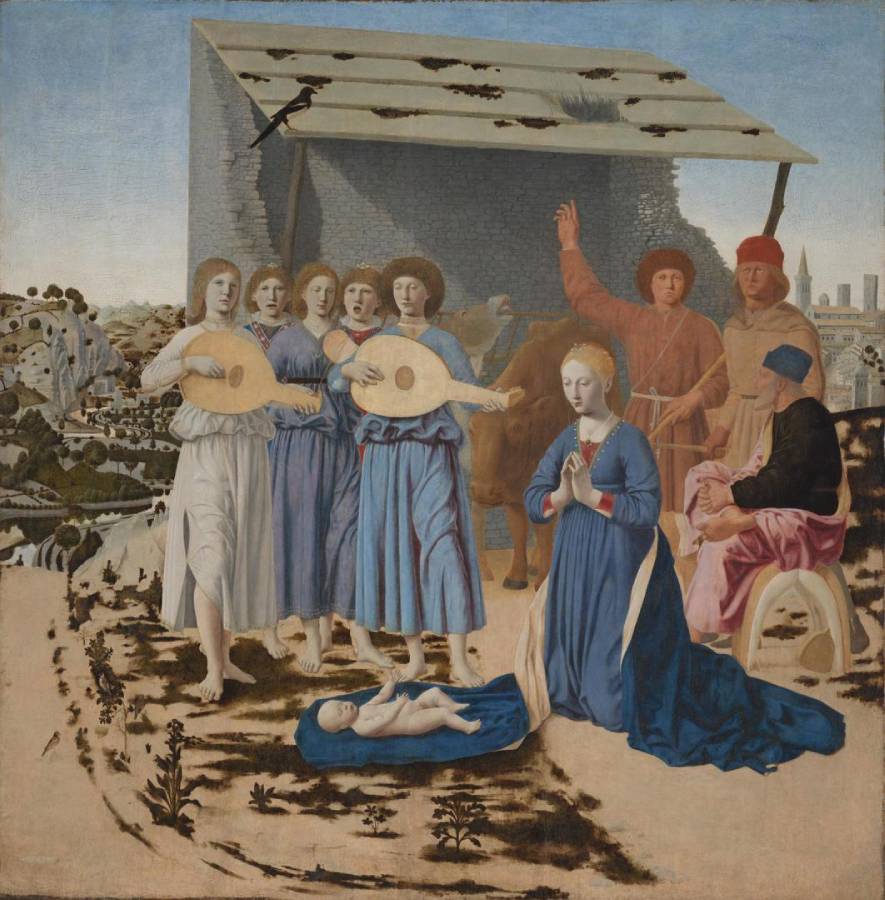Piero della Francesca (c.1416-1492)
Natività (The Nativity)
early 1480s
Oil on poplar, 124.4 x 122.6 cm
National Gallery, London
Piero della Francesca depicted Christ’s Nativity as a miraculous vision materialising on top of a hill near his hometown in rural Tuscany. He based his scene on a famous account by Saint Bridget of Sweden (about 1303–1373), a late-medieval mystic whose revelations were widely read in the fifteenth century.
The Virgin Mary kneels in adoration of her new-born son in front of a ramshackle shed. She is accompanied by her husband Joseph, seated on the donkey’s saddle in a pose drawn from a famous ancient statue known as the Spinario, in which a young boy pulls a thorn from his foot. Behind him are two shepherds, one of whom looks out at the viewer while pointing to the divine light falling on the shed’s stone wall through a hole in its roof, the other apparently following the gesture with his gaze. This has also caught the attention of the braying ass, while the ox lowers his head and gazes at the infant. A group of singing and music-making angels – whose loose, draped clothing evoke classical sculpture – provide a heavenly soundtrack to this otherwise rustic scene, recognising the incarnation of the divine in Christ.
Piero placed the figures within a tranquil Tuscan landscape recalling the surroundings of his hometown of Borgo San Sepolcro. A river meanders through rolling hills peppered with trees at left, while rooftops and a church are visible on the right. By setting Bridget’s vision within a familiar landscape, the artist brought the extraordinary circumstances of Christ’s birth directly into his own world. The scene’s realism is heightened by Piero’s attention to its finer details; three finches perch among the rocks and plants growing in the foreground, while a magpie has settled on the stable’s roof – its run-down character, and the exposed and dusty aspect of the rocky setting emphasise Christ’s humble beginnings.
Within this somewhat desolate and windblown setting, the Virgin Mary’s beauty and serenity as she meditates upon her son are all the more arresting. Her flawless pale complexion and fair hair – covered with a delicate, gauzy veil – follow Renaissance ideals of beauty. Kneeling in veneration before her son, she has offered her deep blue mantle – all she has – to protect his naked skin from the earth. She is depicted as both humble and majestic, her hair and neckline adorned with pearls.
Likely painted in the early 1480s, The Nativity was among Piero’s last works. Its harmonious composition is characterised by the artist’s distinctive cool colour palette and profound luminosity. Thanks to his use of oil paint, its colours appear more saturated than in his Baptism of Christ (NG665), which he executed in egg tempera.
Piero made The Nativity for his family palace in Borgo San Sepolcro where it remained until 1825, initially hung in the principal bedchamber. While still in the family, parts of the paint surface were badly damaged by overcleaning. Subsequent misunderstandings about its condition led some to believe that The Nativity was unfinished. However, restoration of the damaged areas and conservation treatment completed in 2022 brought Piero’s original intention back into focus; such as the composition’s sense of space, the divine light falling on the stable wall, and the figures’ shadows that were intentionally omitted to emphasise the miraculous nature of the event. (NG)
See also:
• Sansepolcro (Italia)
